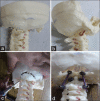Role of Three-dimensional Printing in Neurosurgery: An Institutional Experience
- PMID: 34660365
- PMCID: PMC8477846
- DOI: 10.4103/ajns.AJNS_475_20
Role of Three-dimensional Printing in Neurosurgery: An Institutional Experience
Abstract
Background: Recent advancements in three-dimensional (3D) printing technology in the field of neurosurgery have given a newer modality of management for patients. In this article, we intend to share our institutional experience regarding the use of 3D printing in three modalities, namely, cranioplasty using customized 3D-printed molds of polymethylmethacrylate, 3D-printed model-assisted management of craniovertebral (CV) junction abnormalities, and 3D model-assisted management of brain tumors.
Materials and methods: A total of 55 patients were included in our study between March 2017 and December 2019 at S. M. S Medical College, Jaipur, India. 3D-printed models were prepared for cranioplasty in 30 cases, CV junction anomalies in 18 cases, and brain tumors in 7 cases. Preoperative and postoperative data were analyzed as per the diagnosis.
Results: In cranioplasty, cranial contour and approximation of the margins were excellent and esthetic appearance improved in all patients. In CV junction anomalies, neck pain and myelopathy were improved in all patients, as analyzed using the visual analog scale and the Japanese Orthopedic Association Scale score, respectively. Our questionnaire survey revealed that 3D models for brain tumors were useful in understanding space interval and depth intraoperatively with added advantage of patient education.
Conclusion: Rapid prototyping 3D-printing technologies provide a practical and anatomically accurate means to produce patient-specific and disease-specific models. These models allow for surgical planning, training, simulation, and devices for the assessment and treatment of neurosurgical disease. Expansion of this technology in neurosurgery will serve practitioners, trainees, and patients.
Keywords: Cranioplasty; craniovertebral junction; customized; neurosurgery.
Copyright: © 2021 Asian Journal of Neurosurgery.
Conflict of interest statement
There are no conflicts of interest.
Figures





References
-
- Liew Y, Beveridge E, Demetriades AK, Hughes MA. 3D printing of patient-specific anatomy: A tool to improve patient consent and enhance imaging interpretation by trainees. Br J Neurosurg. 2015;29:712–4. - PubMed
-
- Klein GT, Lu Y, Wang MY. 3D printing and neurosurgery – Ready for prime time? World Neurosurg. 2013;80:233–5. - PubMed
-
- Tai BL, Rooney D, Stephenson F, Liao PS, Sagher O, Shih AJ, et al. Development of a 3D-printed external ventricular drain placement simulator: Technical note. J Neurosurg. 2015;123:1–7. - PubMed
-
- Magerl F, Seemann PS. Stable posterior fusion of the atlas and axis by transarticular screw fixation. In: Kehr P, Weider A, editors. Cervical Spine I. Wien: Springer-Verlag; 1987. pp. 322–7.

